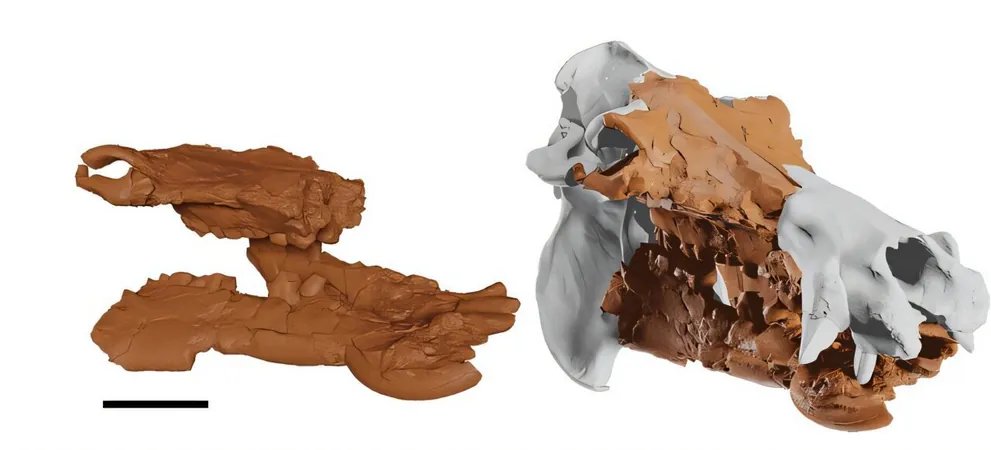
Unearthing the Past: Researchers Successfully Reconstruct Skull of Ancient Cretan Hippo
2024-12-29
Author: Li
Introduction
In an exciting breakthrough for paleontology, researchers Nikolaos Gerakakis and Professor Dimitrios Makris have unveiled a fully reconstructed skull of Hippopotamus creutzburgi, a long-extinct dwarf hippopotamus species that once roamed the island of Crete. Utilizing cutting-edge 3D digital imaging techniques, their findings shed new light on the evolutionary history of this unique animal, which thrived on the island during the Pleistocene epoch.
Significance of the Research
Published in the journal Digital Applications in Archaeology and Cultural Heritage, this meticulous research represents the first complete skull reconstruction of this ancient hippo species. During the Pleistocene, hippos were not just confined to Africa; they adapted to various insular environments, including Cyprus, Madagascar, Malta, and Sicily. The Cretan dwarf hippo is a particularly fascinating outlier in this pattern of island adaptation.
Migration Theory
Gerakakis explains, "The Hippopotamus creutzburgi lived on Crete during the Early-to-Middle Pleistocene. During colder periods of this epoch, lower sea levels and geological shifts in the Aegean gave rise to narrow land bridges, which likely allowed a herd of its ancestor, H. antiquus, to migrate from the Peloponnese. Fossil remains of H. antiquus have supported this theory."
Unique Locomotion Patterns
Interestingly, hippos have unique locomotion patterns; they maintain contact with the ground when swimming and may even be buoyant in saltwater. Gerakakis proposes that juvenile hippos could have had a higher survival rate if caught in sea currents, which may have aided in establishing a stable population on Crete.
Island Rule and Size Reduction
Following their arrival on the island, H. creutzburgi underwent significant size reduction, a phenomenon explained by biologist Leigh Van Valen's "island rule," where larger species tend to evolve smaller sizes in island ecosystems. The reasons for their eventual extinction remain a mystery, with theories proposing anything from natural disasters and harsh climatic changes to competition with newly arrived deer species.
Fossil Evidence and Study Methods
Fossil evidence of H. creutzburgi has primarily been recovered from the Katharó plateau, a site rich in fossil remains but notorious for poorly preserved and fragmented specimens. Remarkably, prior to this study, no complete skull had ever been recovered, rendering the species' skull size and shape a subject of widespread speculation.
Digital Reconstruction Process
By employing advanced photogrammetry, Gerakakis and Makris were able to digitally reconstruct the skull from four fossil remains excavated between 1998 and 2002. Leveraging software like Blender, they utilized a process known as retrodeformation, initially transforming an extremely flattened cranium into an anatomically correct model. The team created an innovative "spider-like" exoskeleton with 23 armatures that allowed for precise restoration of the mandible, a complex part of the skull.
Morphological Analysis
The results reveal that the morphology of H. creutzburgi bears significant similarities to both African hippopotamuses and dwarf Malagasy hippos, suggesting a fascinating evolutionary linkage. The team anticipates that this digital reconstruction can lead to physical exhibits for museums, with plans for a future exhibition at the Katharó plateau already underway.
Future Research Plans
Moreover, steps are being taken to publish a comprehensive reconstruction of the entire H. creutzburgi skeleton, which includes a collaboration with the Laboratory of Vertebrate Paleontology at the National and Kapodistrian University of Athens. While many skeletal elements have been discovered, vertebrae and ribs remain a scarcity, presenting ongoing challenges for researchers.
Conclusion
Stay tuned as ongoing studies continue to unravel the secrets of the Cretan dwarf hippo, pushing the boundaries of our understanding of prehistoric life and its adaptations. This groundbreaking research not only enriches our knowledge of extinct species but also enhances our appreciation for the evolutionary dynamics that shape life on our planet.





 Brasil (PT)
Brasil (PT)
 Canada (EN)
Canada (EN)
 Chile (ES)
Chile (ES)
 Česko (CS)
Česko (CS)
 대한민국 (KO)
대한민국 (KO)
 España (ES)
España (ES)
 France (FR)
France (FR)
 Hong Kong (EN)
Hong Kong (EN)
 Italia (IT)
Italia (IT)
 日本 (JA)
日本 (JA)
 Magyarország (HU)
Magyarország (HU)
 Norge (NO)
Norge (NO)
 Polska (PL)
Polska (PL)
 Schweiz (DE)
Schweiz (DE)
 Singapore (EN)
Singapore (EN)
 Sverige (SV)
Sverige (SV)
 Suomi (FI)
Suomi (FI)
 Türkiye (TR)
Türkiye (TR)
 الإمارات العربية المتحدة (AR)
الإمارات العربية المتحدة (AR)